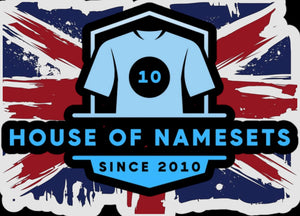Introduction: The Premier League, renowned for its thrilling matches and iconic players, has not only shaped the landscape of football but also influenced the culture surrounding it. One of the most distinctive elements of this culture is the nameset—the printed name and number on the back of a player's shirt. Over the years, namesets have evolved from simple identifiers to symbols of identity and pride for both players and fans. This blog explores the fascinating journey of namesets in the Premier League, highlighting key changes and their impact on the sport.
Early Days: In the early 1990s, as the Premier League was born, namesets were introduced as a way to help fans and commentators easily identify players on the pitch. Initially, these namesets were basic, often featuring simple block letters and numbers. The focus was primarily on functionality rather than aesthetics. Fans quickly embraced this new feature, as it allowed them to connect more personally with their favorite players. The introduction of namesets marked the beginning of a new era in football merchandising, paving the way for personalized fan experiences.
Technological Advancements: As technology advanced, so did the quality and design of namesets. The introduction of new materials and printing techniques allowed for more intricate and durable designs. Heat transfer technology replaced traditional sewing methods, resulting in lighter and more comfortable shirts for players. This shift not only improved the performance of the kits but also opened up creative possibilities for designers. Clubs began experimenting with different fonts and colors, adding a unique flair to their kits and enhancing the visual appeal of the game.
Design Trends: Over the years, nameset designs have undergone significant transformations. In the early days, blocky and straightforward fonts were the norm. However, as clubs sought to strengthen their brand identities, namesets became more stylized. The influence of club branding and sponsorships played a crucial role in shaping these designs. For instance, some clubs opted for sleek, modern fonts that aligned with their overall aesthetic, while others embraced bold and distinctive styles to stand out. The evolution of nameset designs reflects the dynamic nature of football culture and its ability to adapt to changing trends.
Regulatory Changes: The Premier League has implemented various regulations regarding namesets to ensure consistency and fairness across the league. These regulations dictate aspects such as font size, color contrast, and placement on the shirt. Over time, these rules have evolved to accommodate technological advancements and aesthetic preferences. For example, the introduction of sleeve sponsors led to adjustments in nameset placement to maintain visibility and balance. These regulatory changes have had a significant impact on clubs and manufacturers, requiring them to innovate while adhering to league standards.
Cultural Impact: Namesets have become an integral part of football culture, serving as symbols of identity and pride for fans. They allow supporters to showcase their allegiance to their favourite players and clubs, creating a sense of belonging and community. Memorable namesets, such as those worn by iconic players like David Beckham and Thierry Henry, have become synonymous with unforgettable moments in football history. The cultural impact of namesets extends beyond the pitch, influencing fashion trends and merchandise sales. Fans proudly wear shirts adorned with their favorite namesets, turning them into cherished collectibles.
Future of Namesets: As we look to the future, the evolution of namesets shows no signs of slowing down. With advancements in technology and design, we can expect even more innovative and personalized nameset options. Augmented reality and digital customization may allow fans to create unique namesets that reflect their individuality. Additionally, sustainability is likely to play a significant role, with eco-friendly materials and production methods becoming more prevalent. The future of namesets promises to be an exciting blend of tradition and innovation, continuing to captivate fans worldwide.
Conclusion: The journey of namesets in the Premier League is a testament to the ever-evolving nature of football culture. From their humble beginnings as simple identifiers to their current status as symbols of identity and pride, namesets have become an integral part of the beautiful game. As we celebrate the rich history and cultural significance of namesets, we invite fans to share their favourite nameset memories and look forward to the exciting developments that lie ahead.


